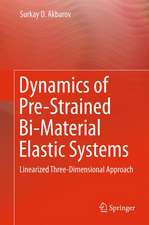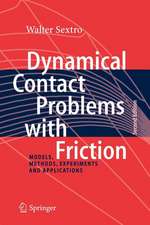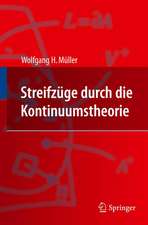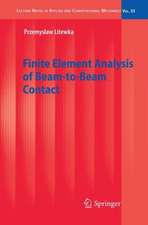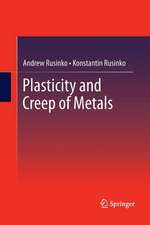Plasticity-Damage Couplings: From Single Crystal to Polycrystalline Materials: Solid Mechanics and Its Applications, cartea 253
Autor Oana Cazacu, Benoit Revil-Baudard, Nitin Chandolaen Limba Engleză Paperback – 20 dec 2018
| Toate formatele și edițiile | Preț | Express |
|---|---|---|
| Paperback (1) | 1211.04 lei 38-45 zile | |
| Springer International Publishing – 20 dec 2018 | 1211.04 lei 38-45 zile | |
| Hardback (1) | 1354.45 lei 38-45 zile | |
| Springer International Publishing – 2 aug 2018 | 1354.45 lei 38-45 zile |
Din seria Solid Mechanics and Its Applications
- 20%
 Preț: 698.10 lei
Preț: 698.10 lei - 24%
 Preț: 800.16 lei
Preț: 800.16 lei -
 Preț: 402.14 lei
Preț: 402.14 lei - 15%
 Preț: 640.06 lei
Preț: 640.06 lei - 15%
 Preț: 653.14 lei
Preț: 653.14 lei - 18%
 Preț: 1124.92 lei
Preț: 1124.92 lei - 15%
 Preț: 643.84 lei
Preț: 643.84 lei - 18%
 Preț: 1119.38 lei
Preț: 1119.38 lei - 20%
 Preț: 573.20 lei
Preț: 573.20 lei - 18%
 Preț: 1607.92 lei
Preț: 1607.92 lei - 17%
 Preț: 393.72 lei
Preț: 393.72 lei - 17%
 Preț: 459.41 lei
Preț: 459.41 lei - 18%
 Preț: 959.98 lei
Preț: 959.98 lei - 18%
 Preț: 747.71 lei
Preț: 747.71 lei -
 Preț: 388.55 lei
Preț: 388.55 lei - 18%
 Preț: 787.15 lei
Preț: 787.15 lei -
 Preț: 406.25 lei
Preț: 406.25 lei - 15%
 Preț: 639.08 lei
Preț: 639.08 lei - 24%
 Preț: 784.84 lei
Preț: 784.84 lei - 15%
 Preț: 643.34 lei
Preț: 643.34 lei - 18%
 Preț: 958.07 lei
Preț: 958.07 lei - 18%
 Preț: 1228.15 lei
Preț: 1228.15 lei - 18%
 Preț: 734.27 lei
Preț: 734.27 lei - 18%
 Preț: 1233.06 lei
Preț: 1233.06 lei - 18%
 Preț: 1236.19 lei
Preț: 1236.19 lei - 18%
 Preț: 950.96 lei
Preț: 950.96 lei - 18%
 Preț: 906.48 lei
Preț: 906.48 lei - 18%
 Preț: 964.54 lei
Preț: 964.54 lei - 20%
 Preț: 995.75 lei
Preț: 995.75 lei - 18%
 Preț: 953.65 lei
Preț: 953.65 lei - 18%
 Preț: 1239.67 lei
Preț: 1239.67 lei - 18%
 Preț: 962.35 lei
Preț: 962.35 lei - 18%
 Preț: 964.54 lei
Preț: 964.54 lei - 18%
 Preț: 913.11 lei
Preț: 913.11 lei - 18%
 Preț: 1226.90 lei
Preț: 1226.90 lei
Preț: 1211.04 lei
Preț vechi: 1593.47 lei
-24% Nou
Puncte Express: 1817
Preț estimativ în valută:
231.74€ • 247.80$ • 193.21£
231.74€ • 247.80$ • 193.21£
Carte tipărită la comandă
Livrare economică 14-21 aprilie
Preluare comenzi: 021 569.72.76
Specificații
ISBN-13: 9783030065478
ISBN-10: 3030065472
Pagini: 581
Ilustrații: XIII, 581 p. 301 illus., 198 illus. in color.
Dimensiuni: 155 x 235 mm
Ediția:Softcover reprint of the original 1st ed. 2019
Editura: Springer International Publishing
Colecția Springer
Seria Solid Mechanics and Its Applications
Locul publicării:Cham, Switzerland
ISBN-10: 3030065472
Pagini: 581
Ilustrații: XIII, 581 p. 301 illus., 198 illus. in color.
Dimensiuni: 155 x 235 mm
Ediția:Softcover reprint of the original 1st ed. 2019
Editura: Springer International Publishing
Colecția Springer
Seria Solid Mechanics and Its Applications
Locul publicării:Cham, Switzerland
Cuprins
Preface.- 1 Mathematical Framework.- 2 Mathematical Framework of Plasticity Theory.-Part I: Elastic-Plastic Models for Single-Crystals.- 3 Elements of Crystallography.- 4 Modeling Plastic Deformation of Single Crystals.- Part II CONSTITUTIVE Models for ISOTROPIC PolycryStals.- 5 Modeling Plastic Deformation of Isotropic Polycrystals: Stress-Based Formulations.- 6 Modeling Plastic Deformation of Isotropic Polycrystals: Strain-Rate Based Formulations.- Part III CONSTITUTIVE Models for ANISOTROPIC MATERIALS.- 7 Modeling Plastic Deformation of Textured Polycrystals: Stress-Based Formulations.- 8 Modeling Plastic Deformation of Textured Polycrystals: Strain-Rate Based Plastic Potentials.- Part IV: ROLE OF PLASTIC DEFORMATION ON DAMAGE EVOLUTION.- 9 Effect of Plastic Deformation on Damage Evolution in Porous Isotropc Metallic Materials.- 10 Modeling the Effect of Plastic Deformation on Damage Evolution in Porous Anisotropic Metallic Materials.- Index.
Textul de pe ultima copertă
Offering a well-balanced blend of theory and hands-on applications, this book presents a unified framework for the main dissipative phenomena in metallic materials: plasticity and damage. Based on representation theory for tensor functions and scale-bridging theorems, this framework enables the development of constitutive models that account for the influence of crystallographic structures and deformation mechanisms on the macroscopic behavior. It allows readers to develop a clear understanding of the range of applicability of any given model, as well as its capabilities and limitations, and provides procedures for parameter identification along with key concepts necessary to solve boundary value problems, making it useful to both researchers and engineering practitioners. Although the book focuses on new contributions to modeling anisotropic materials, the review of the foundations of plasticity and models for isotropic materials, completed with detailed mathematical proofs mean that it is self-consistent and accessible to graduate students in engineering mechanics and material sciences.
Caracteristici
Provides a unified treatment of plastic anisotropy and damage and a rigorous methodology for formulation of constitutive models incorporating information at multiple length scales Documents the latest research on plastic anisotropy and damage of engineering materials including modern metallic alloys with hexagonal crystal structures Presents fundamental and applied material, including theory, numerical Implementation, experimental validation and applications that are useful for engineering practitioners, researchers, and graduate students

